Greenwich St. Jewelers, New York, NY
OWNERS: Jennifer Gandia and Christina Gandia Gambale; URL: greenwichjewelers.com; FOUNDED: 1976; OPENED FEATURED LOCATION: 2022; AREA: 1,550 square feet; ARCHITECT AND DESIGN: MAOarch, Wield Creative; TOP BRANDS: Alice Cicolini, Eva Fehren, Jamie Joseph, Lorraine West, Marla Aaron, Single Stone, Sylva & Cie, TEN THOUSAND THINGS, WWake; EMPLOYEES: 17; ONLINE PRESENCE: 89,000 followers on Instagram; 620 Google reviews with 4.9 Star average

Sisters Jennifer Gandia and Christina Gandia Gambale; PHOTO CREDIT: Alain Simic
SISTERS JENNIFER GANDIA and Christina Gandia Gambale were inspired by elements of residential design for their new Greenwich St. Jewelers store in Tribeca, and the concept was so successful that their clients now say they want to live there.
That residential vibe began with the selection of their space in a neighborhood that’s a comfortable mix of residential and commercial with a strong community feel, the kind of community their parents Carl and Milly Gandia knew when they opened the original Greenwich Jewelers in the Financial District in 1976, after emigrating from Puerto Rico.
Retail neighbors in Tribeca are an eclectic mix that include the Balloon Saloon party supplies and gifts; Korin, a Japanese cutlery store patronized by chefs; the Mysterious Book Shop; lifestyle and fashion businesses, children’s stores, galleries and restaurants.
AMERICA’S COOLEST STORES 2023 SPONSORS
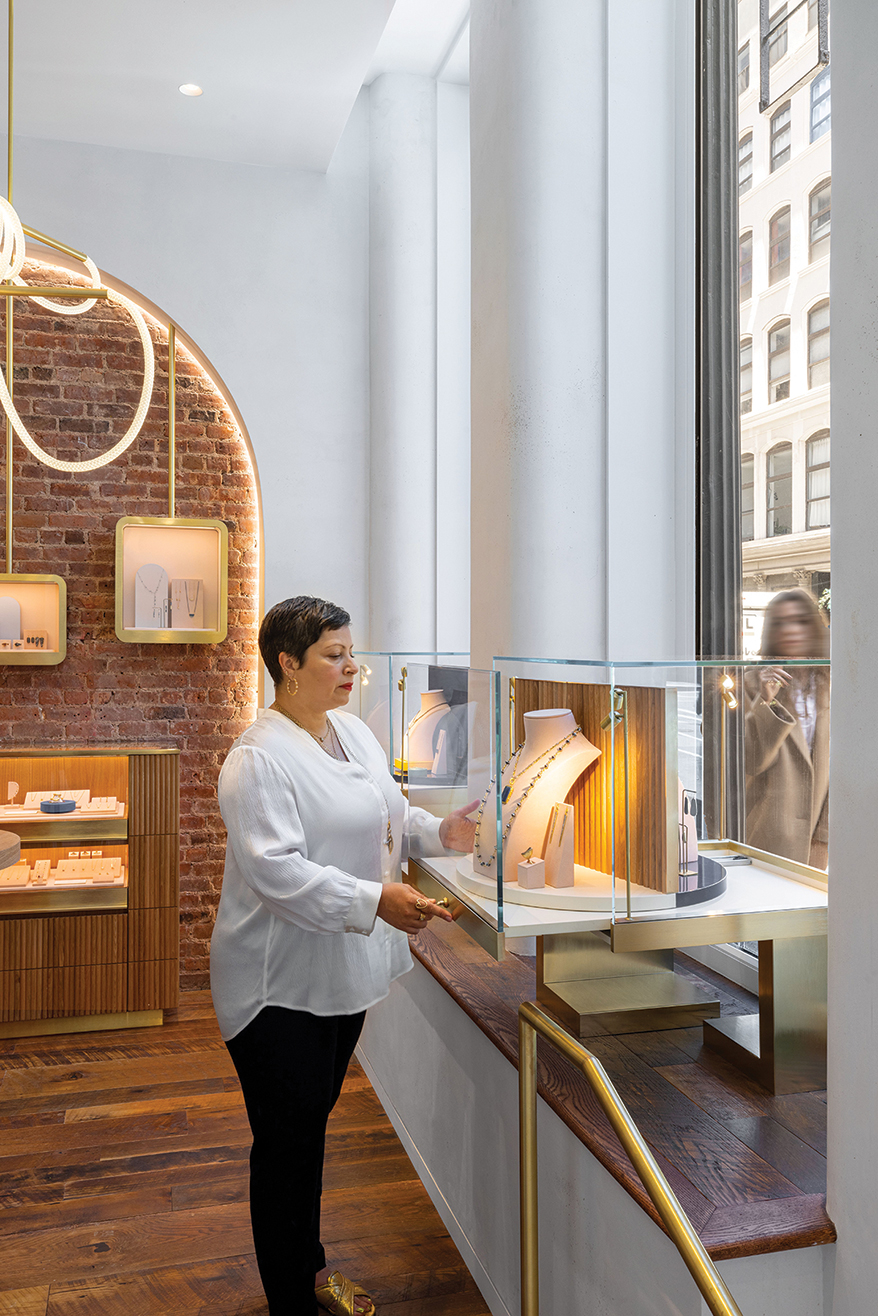
The new Greenwich St. opened last year on Reade Street in the city’s second oldest cast iron building, known as the Obsidian House, built in 1857. The original facade has been carefully restored and the upper floors are all residential. “The space itself we knew was the right space right away,” says Jennifer Gandia. “Something just felt right. The historical and beautiful architecture of Tribeca appealed to us.”
They wanted it to feel luxurious, but not pretentious.
“We wanted the store to feel very downtown New York and welcoming and homey, and in New York that means an apartment,” Gandia says. “It was all about creating a concept that felt warm and energizing with bright color and sumptuous fabrics. We didn’t want a sterile, neutral store.”
Senior marketing manager Grace Barretti describes the color scheme as acid brights mixing with pastels and jewel tones in a playful yet sophisticated way. Showcases feature a variety of finishes, and jewelry forms designed by Wield Creative complement the color explosion. The bathroom’s vibrant gingko leaf tiles reference the sisters’ Puerto Rican ancestry while offering another aesthetic surprise.
Mirroring the layout of a classic New York City railroad apartment, the space is divided into rooms that showcase the work of 40-plus independent designers.
“These were the kind of apartments you saw a lot in tenement buildings, rooms all in one line,” Gandia says. “That in itself is very New York.”
Typically, a foyer flows into living room, kitchen, dining room and finally, a more intimate bedroom space at the back.
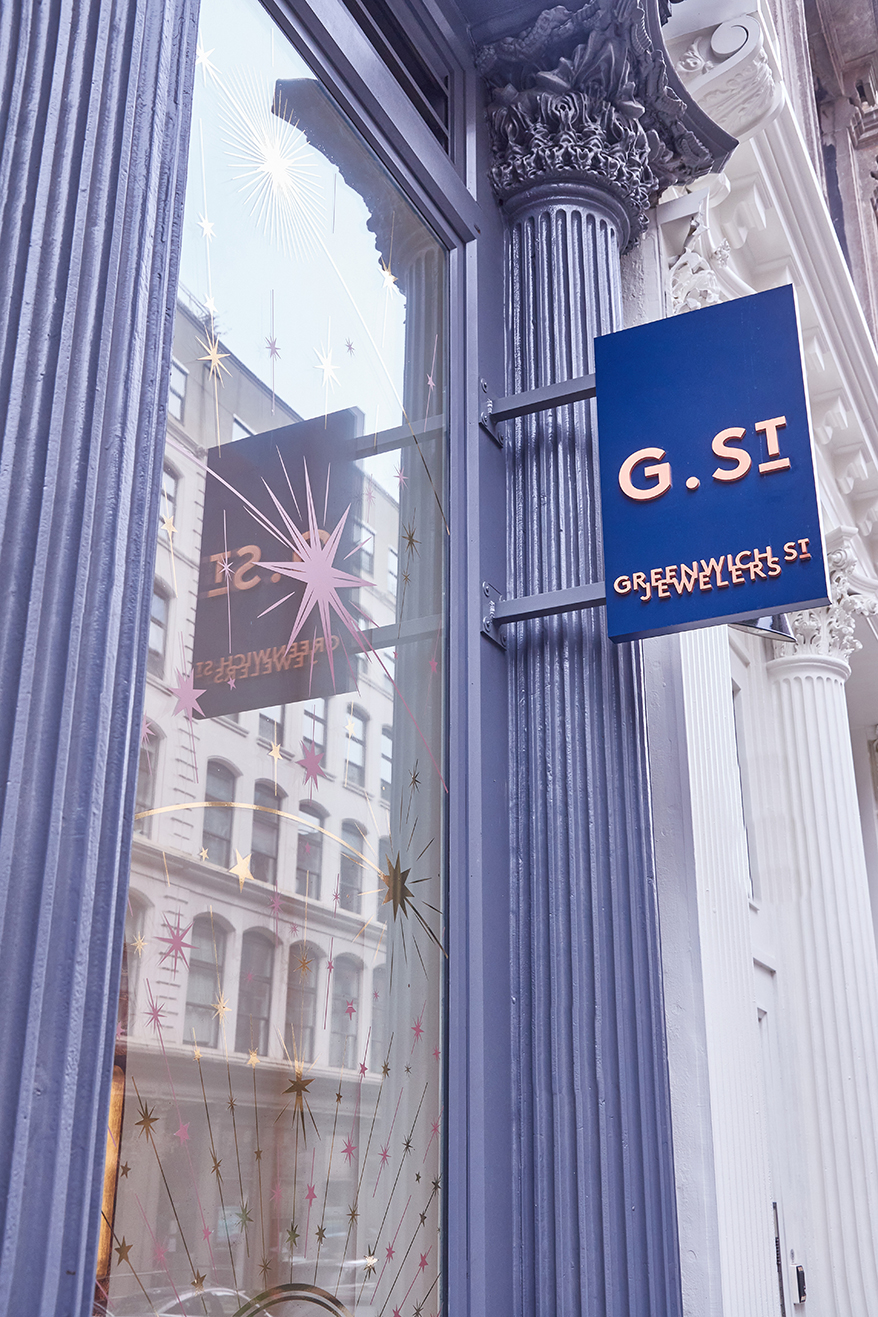
In this case, a collection of Jamie Joseph rings in an eye-catching pink display beckons to visitors in the entry foyer and immediately invites them to play with the jewelry and try something on. “There is a different threshold in each room and an element of discovery, which is why there are a lot of different elements in the store, different surfaces, a lot of colors,” Gandia says.
The second room beckons with a sumptuous velvet couch and in the third, a large central showcase conjures images of a formal dining room.
Toward the back, there’s space for custom consultations as well as a private room with glass doors off to the side that represents an outdoor terrace. Overhead lighting is carefully crafted to appear natural. “I think our lighting guy was an artist,” says Gandia. “The lighting in this store, if I do say so myself, is spectacular. You don’t notice it, and that’s the point.”
The original brick arch was the inspiration for using a repeating arch motif to organize the space and create drama.
Ultimately each room was a puzzle piece, or square in a quilt, that had its own smaller unique personality but when all paired together they sing in unison, noted Nico Pallotto, senior associate with MAOarch Architecture.
The store design and material selections demanded a willingness to take risks and cultivate a sense of adventure. Surfaces include lacquer, tabor, a dyed wood facade on the cash wrap, engineered oak plank on the floor, with a layer of reclaimed oak. “We have velvet, we have neon. And it’s a very New York thing to do, to take risks,” Gandia says.
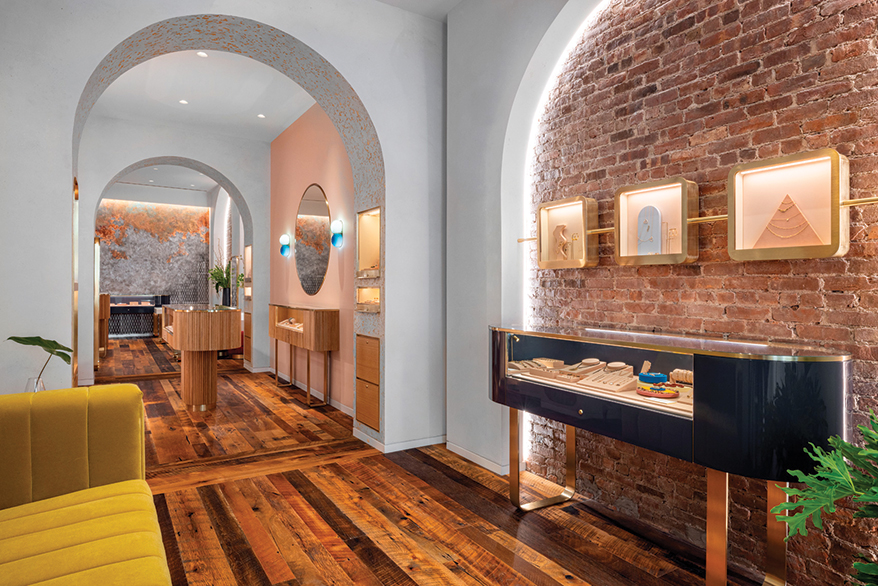
In particular, Gandia says, the feature wall in the back involved quite a few discussions. “We threw a lot of spaghetti at the wall to see what was going to stick,” Gandia says. “Should it be a mural, should it be an installation of mirrors? Gem specimens? Hands reaching out and holding jewelry? We had lots of Pinterest boards with crazy things on them.”
The winning idea came from muralist Mason Nye, who pressed a custom subway grate stencil into the plaster. “Everything else was very pretty and we thought we needed something to add edginess, to scuff it up a little,” Gandia says. “We need something that feels like the sidewalks, the streets, of the city. New York is pretty, but gritty. We needed that bit of grittiness.”
An artist infused the plaster with flecks of mica, a backdrop for art installations. East Village artist Rosalie Knox rendered an original painting in nail polish, which glows in the dark under black light. The chandelier in the front of the store resembles a freeform tangle of hanging chains or New York City grafitti suspended in midair.
Advertisement
From the Beginning
Christina and Jennifer grew up playing on the shop floor of Greenwich St. Jewelers in its original Financial District location, watching their parents work in the store and at the bench.
The family business faced periods of adversity, from the 9/11 terrorist attacks that destroyed the original store, to the Great Recession, Hurricane Sandy, and a pandemic. Loyal clientele supported them through every setback.
Gandia, who studied at the Fashion Institute of Technology, joined the business in 2003, using her public relations and marketing experience in the fashion industry to help her parents recover after 9/11. Her efforts evolved into identifying independent designers to carry, modernizing the infrastructure, and pioneering the digital marketing landscape.
Gandia Gambale officially signed on in 2007, after she finished her education in finance at Fordham University and became a GIA-certified gemologist.
At that time, the independent jewelry designer movement began to take off, creating a synergy between the kind of jewelry the sisters wanted to sell and the kind of jewelry that was available. “The independent designer movement that we know today really started in the early 2000s; 2006, 2007,” Gandia says. “As a younger generation we wanted to sell things that we liked, and the timing made it easier because there were shows where a retailer could find more independent designers.”
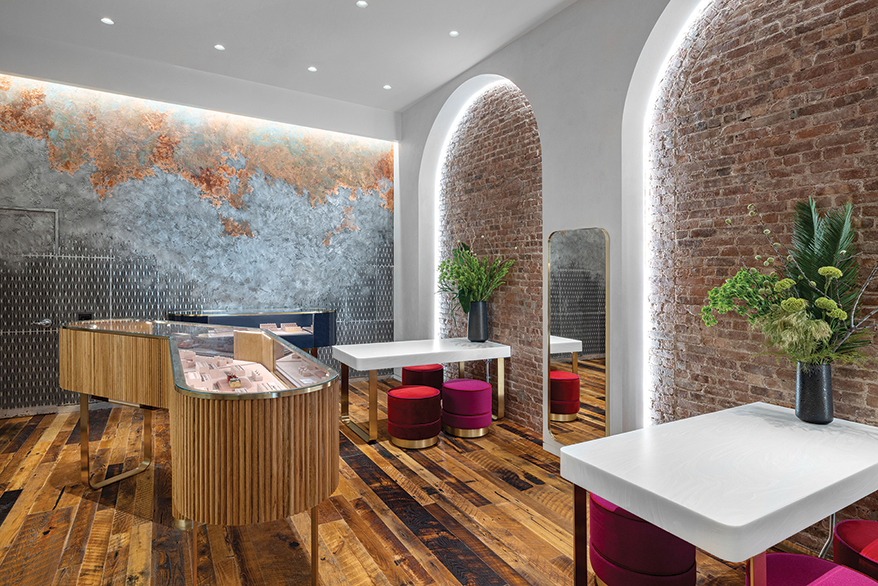
They continue to support emerging designers to capture their clients’ imaginations and help them expand their personal collections. “Being known for having an offering that is beautiful, intentional, and well-made is all very important to us,” Gandia says.
Before the sisters had found their Tribeca space or begun to design it, their father died. During construction of the new store, when Gandia Gambale was helping her mother move, she found a book of store design concepts her father had been sketching that now seem prescient. He had drawn arches, a brick wall and even a window that resembles the interior window of the terrace. “We had talked about moving while he was alive,” Gandia Gambale says, “and this felt like a nod of support.”
In turn, the sisters honor the roots of their family business by maintaining the service element, upon which their parents built their business and established links to their community.
“In New York, you don’t find a jeweler very often who can do a bit of everything, that has a full shop, and does custom design, repair, restoration, bridal, fine jewelry and designer jewelry,” Gandia Gambale says. “It’s a point of differentiation for us among our competitors” as well as a gift to the community.
Nico Pallotto says the design team considers the entire project a love letter from Greenwich Street Jewelers to New York City. “We believe everyone can feel the vibe without it being a cliche of stereotypical New York City elements splashed all over the space. It feels familiar, relaxed, approachable, but also elevated.”
People are drawn in, whether they stop by for a repair, to design a custom ring, or simply out of curiosity. When they cross that threshold and embark on a retail adventure, they are often surprised to find such a warm, welcoming place, backed by an incredible team trained to engage shoppers and to make them feel happy.
“That’s why people want to live here,” Gandia says.
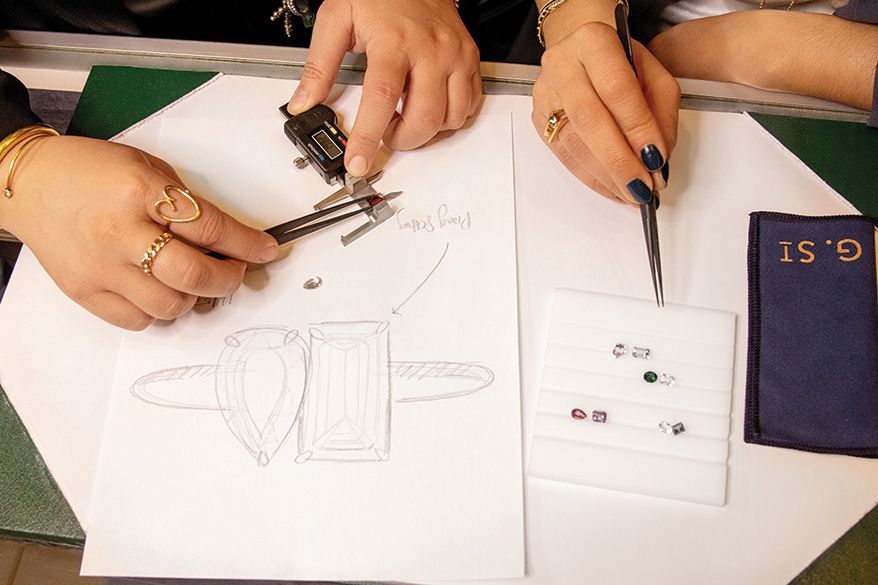
Greenwich St. Jewelers created a Toi et Moi ring capsule collection to showcase their use of traceable gems and Fairmined gold.
Five Cool Things About Greenwich St. Jewelers
1. TEAM BUILDING. The goal is to hire collaborative team members with an entrepreneurial spirit. “We have people with incredible experience, background and creativity,” says Gandia. The team consists of artists, opera singers, tarot readers, models, crocheters, fashion lovers and drag queens. Each team member’s birthday or work anniversary is celebrated with a lunch or a treat, like a visit from an ice cream truck or an in-store charcuterie spread. “To thank them,” Gandia Gambale says, “and to let them know we’re thinking of them.”
2. CREATIVE COLLECTION LAUNCH. Greenwich St. hosted an event for the launch of a jewelry collection, partnering with an astrologer who gave readings about the participant’s zodiac signs. The goal was to empower potential clients to learn more about how the stars align for them in their lives, an important inspiration to Gandia, who designed the ASTRA collection of zodiac charms. They also collaborated with an Aura reader.
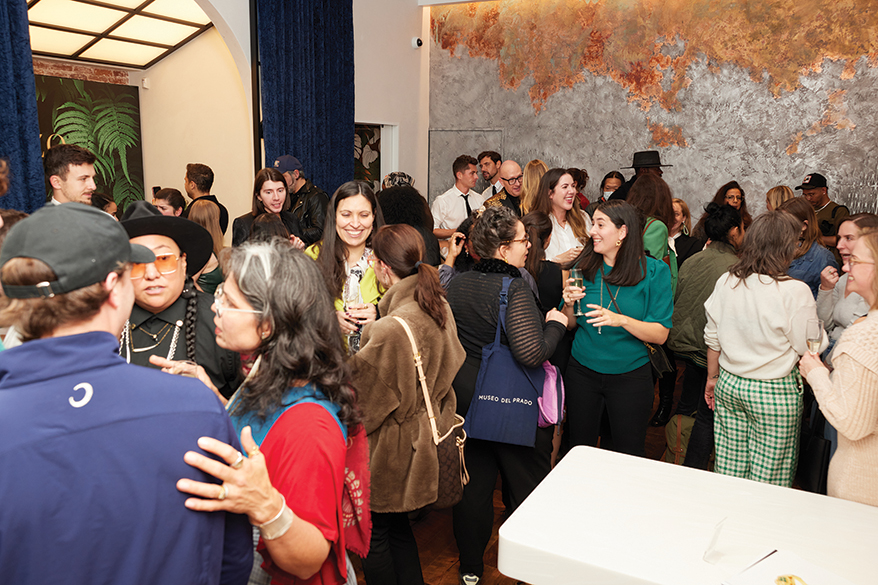
The Reade Street location, twice the size of the former store, has been the site of multiple in-store events.
3. RESPONSIBLE SOURCING. Greenwich St. achieved Fairmined certification and created a Toi et Moi ring capsule collection, hand-crafted in their workshop, to showcase their use of traceable gemstones and Fairmined gold. They began offering De Beers Code of Origin diamonds and GIA Diamond of Origin to present traceable diamonds that do good in the country they come from, such as providing jobs, healthcare and education.
4. THE PRIZE. The Greenwich St. architectural dream team, Maori Hughes, MAOarch owner/principal, and Nico Pallotto, senior associate, were awarded one of a very few honorable mentions for Greenwich St. Jewelers in the international architecture awards, 11th Annual A+ Awards hosted by Architizer in the Global Retail category, competing against entries from more than 90 countries.
5. VERSATILE DISPLAY. The window vitrines turn 360 degrees and have distinct design styles on either side. This allows for flexibility in display and ease when anyone wants to try on what they see in the window, making the transition from outdoor passersby to indoor shopping seamless.
PHOTO GALLERY (16 IMAGES)
JUDGES’ COMMENTS
- Jesse Balaity: Greenwich St. Jewelers nails a key part of retailing with which so many jewelers struggle: the encouragement of exploration. Too often, jewelry stores present as either a sea of showcases or a collection of unrelated departments. But here we have a small space that plays with texture, scale, materials, and lighting in a manner that lets each collection shine. The material choices are brilliant, too, demonstrating how modest choices and earthy tones can connect with customers every bit as much as fancy marble and chandeliers.
- JACKIE BROOKS:These ladies do not leave a stone unturned. I was motivated when reading their story and I felt like I got to experience a small piece of G. St. when reading their submission. Bravo!
- LARRY JOHNSON: A great concept, perfectly executed and well suited for their clientele.
- REBECCA RAU:The attention to detail within the physical space is amazingly striking. I’d be determined to find something to take home in an inspiring space like this!
- MEG TERRY:This store is stunning. The elegance of restraint to let the building and the jewelry tell the story is refreshing. This store is most certainly “of its time” with the attention to detail in the wood and brass work that speaks to the design aesthetic of the past and the future. All the pieces align from the story to the online presence, the marketing, and most certainly, the space. I want to experience this store!
Try This: Get Involved.
The sisters share a commitment to responsible sourcing, supporting mentorship and philanthropic causes, and championing diversity and inclusion in the fine jewelry space. Both are dedicated to giving back, with Gambale sitting on the board of directors of Diamonds Do Good and Gandia on the advisory board of the Black In Jewelry Coalition, NYC Jewelry Week.
Fun Fact: Serendipity.
In 1843, before the original structure was razed and rebuilt with a cast iron facade in 1857, the address was the home of James H. Shaw’s jewelry business, one of several jewelry and silversmith businesses on Reade Street at the time.
ONLINE EXTRA
Q & A With Nico Pallotto, senior associate with MAOarch Architecture Firm
Greenwich St. Jewelers owners Jennifer Gandia and Christina Gandia Gambale partnered with MAOArch architecture firm, led by Maori Fujisaki Hughes, to design their new flagship store in New York City. Greenwich St. Jewelers is the No. 1 winner in the Big Cool category of the 2023 America’s Coolest Stores contest.
We asked Nico Pallotto, senior associate with MAOarch, to explain in detail some of the magic behind the store’s unique design.
Q. There is so much going on in the interior of Greenwich St. Jewelers, in a good way! How do the many layers work?
A. We like to think of this store as a love letter to New York City from G. St & MAOarch. This love letter celebrates the complexity and layers of the dense city blocks, a diverse population, diversity of eateries, smells, noise, speeds, and rich layers of history, all of which gives New York City that je ne sais quoi. You can’t put your finger on everything all at once, but the pieces come together as you travel from front to back and back to front of this TriBeCa flagship. It feels familiar, relaxed, approachable, but also elevated.
Simultaneously, our goal was to execute the sequence of materials in a way that doesn’t feel overwhelming and is curated and considered. Architecturally, with the help of Hyde Park Moldings of New York, we combined the softness of the custom white plaster walls that are embedded with flecks of mica and crushed pieces of clear glass, with the softness of reclaimed American oak floors that act as the foundation and backdrop for the material palette.
These main materials are balanced with the textures of fine mosaic tiles on the floor, pockets of original brick wall and undersides of arches hand troweled with a gold and cream textured plaster, as well as the custom feature wall.
That feature wall, at the rear of the space, is inspired by the texture of the often overlooked New York City sidewalk/subway grates. Its material transitions, such as oxidized copper and metallic gray lime plaster, were masterfully executed by local muralist Mason Nye, and in the end alludes to the steam one would walk through passing overtop any street grate.
At the bottom half is a custom-made raised plaster subway grate built out of laser cut templates and layers of dark gray and metallic silver custom lime plaster. The result is a 3D extruded plaster surface that travels along the width of the wall, steps up and down, and partially conceals the door to the back of house. It felt like it was an original old wall discovered and exposed during construction.
As you proceed through the space from front to back the visual and tactile story begins to layer and then expand as you reach the main (bridal) salon and feature wall. It’s just like walking through your friend’s chic Soho loft. A crescendo at the end of the space was important.
Advertisement
Q. Tell us about the layers of lighting
A. Lighting is key to any successful jewelry shop or store. Here at G.ST there are many types and levels of artificial lighting mixed with soft northern natural light. There is warm lighting with a nod to residential spaces that beams down from the ceiling; you don’t see the light coming down. The perimeter walls flanking the long sides of the space have continuous arches revealed between plaster and brick walls that help brighten and feel as if they expand the width of the space.
Our lighting designer also mentioned the ceiling would provide a dome of warm light similar to a residence. Sconces, bookcase accent lights and picture lights over artwork add another layer of ambience or highlight various rooms and provide balance, warmth and sparkle.
Finally, the foyer is illuminated by customized brass stems draped in illuminated braided ropes that resemble the gestural moves of graffiti floating in space, and/ or the ropes once used on pulleys for moving goods from New York City sidewalks to basement vaults. The chandelier is a celebration of our greatest muse, New York City, and downtown’s gilded age.
Q. How do so many distinctive design elements and ideas work together so well in a relatively small space?
A. From a spatial perspective, our tactic was how to make sure that the space felt like you could breathe, that you didn’t feel like there were barriers in the way.
Also, we strategically placed architectural elements that created moments of expansion and contraction of the space.
Although our material palette, which we were calling our “material universe” could read as overwhelming or an overload of materials, colors, textures, and patterns, when one would see it for the first time, we made sure that we utilized the mood board to strategically sprinkle interesting patterns or colors of materials throughout the space, and also study their proportions /size in relation to the overall space and size of the rooms.
Ultimately each room was a puzzle piece, or square in a quilt, that had its own smaller unique personality but when all paired together they sing in unison.
We also wanted to make sure that the materials were a combination of luxurious looking and feeling materials balanced with more humble materials that felt contextualized to this particular TriBeCa neighborhood and history.
We took advantage of extremely tall ceilings, paired with narrow spaces in the horizontal direction, and added a series of specially carved arches to modulate the tall vs. narrow, and essentially trick the eye and body into it feeling like a comfortable space. Supporting this larger architectural maneuver, the bookcase, wall niches, wall mounted vitrines, hanging vitrines, free standing fixtures against walls or in the middle of the space, soft custom furnishings, and unique accessories all play a part in eliminating the feeling that you are in a long narrow tunnel or a small crowded space.
Q. How did the concept of a New York City apartment inform the layout?
A. The raw, original space we were provided with was long and narrow and it naturally felt like a NYC railroad apartment mixed with the expansive identities of neighboring SoHo lofts.
The program for the space developed from the hybridization of the two typologies above. It became a procession of rooms that had their own identities, allowed for a sense of enclosure but also felt open to other rooms. The strategy was to entice customers to feel this expansion and contraction of space, allowing them to slow down, temporarily disengage from the frenzy outside, embrace the space and most importantly engage the product and fine jewelry associates. In addition, the joint residential-retail energies of the rooms allow customers to feel comfortable away from the busy streets, but also when inside the pretension that can typically be felt in larger jewelry stores could be eliminated. It also allows for a more personal approach because of the familiar vibe of the spaces, the integration of a side-by-side selling approach and interactive display showcases fixtures.
Advertisement
Q. What stands out for you in memory about this project?
A. Right before the soft opening, Christina and Jennifer shared a sketchbook they found in the attic a few months before the opening. It was a newer sketchbook of their not too recently passed father. When he heard that Christina and Jennifer had suggested looking for a new space to build out a new location, in secret he began sketching his dream store, which was full of arches and a feature wall that was a nod to time. When we saw these sketches, while our clients were merchandising the store, it brought tears to our eyes because the entire time we were designing, without him being present and providing opinions, we ended up utilizing arches and brick walls as the grand gestures to create impact, to modulate and organize the space. Not having used arches in the past in our designs, it truly felt like he was with us and guiding from above and speaking thorough our architectural sketches, plans, and material selections to create a dream space for a beautiful, unique and successful GST flagship in NYC.
Nico Pallotto joined MAOarch in 2021 with an extensive experience in luxury retail, residential and commercial projects. As Senior Associate, he leads a team of designers and architects on luxury retail and specialty projects including Greenwich St. Jewelers, Carolina Herrera, Stefano Ricci, Burberry, Bergdorf Goodman and Wildlike.
MAOarch is a NYC-based full-service architecture firm, specializing in luxury retail and commercial projects of all scales and sizes. The firm was founded by Maori Fujisaki Hughes, AIA in 2018, a registered architect with extensive experience working with renowned luxury retail brands, both nationally and internationally.